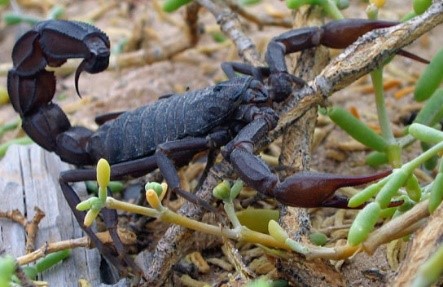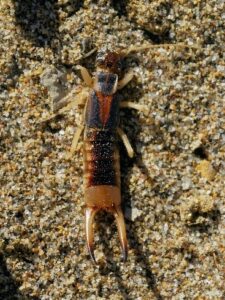Arabian Fat-Tailed Scorpion or Black Scorpion – Androctonus crassicauda (Olivier)
General Description
| · Adults of the Arabian fat-tailed scorpions or black scorpions can vary in color from light brown to reddish to blackish-brown, to black. The adult female can grow to over 10 cm in length.
· Antennae are absent and the mouthparts are formed by small pincer-like chelicerae (fangs). |

Credit: Per-Anders Olsson |
- There is a pair of dorsal eyes and two to five smaller pairs of lateral eyes.
- There are four pairs of walking legs.
Life Cycle and Common Characteristics
- The courtship starts with the male grasping the female’s pedipalps with his own; the pair then perform a special dance.
- When the male identifies a suitable location, he deposits the spermatophore and then guides the female over it. This allows the spermatophore to enter her genital opercula, which triggers the release of sperm, thus fertilizing the female.
- The mating process can take from 1 to 25 hours and depends on the ability of the male to find a suitable place to deposit his spermatophore.
- Once the mating is complete, the male and female separate. The male retreat quickly to avoid being cannibalized by the female (although sexual cannibalism is infrequent with scorpions).
- Scorpions are viviparous (born live). The young are carried about on their mother’s back until they undergo at least one molt.
- Before the first molt, scorplings cannot survive naturally without the mother, since they depend on her for protection and to regulate their moisture levels.
- The size of the litter depends on the species and environmental factors and can range from 2 to 100 scorplings. The average litter consists of around 8 scorplings.
- The young generally resemble their parents.
- A scorpion’s developmental progress is measured in instars. This scorpion requires 5 to 7 molts to reach maturity.
- The process of hardening is called sclerotization. The new exoskeleton does not fluoresce, but the fluorescence gradually returns.
- Scorpions are known to glow when exposed to certain wavelengths of ultraviolet light due to the presence of fluorescent chemicals in the cuticle.
- They live in the ruins of neglected structures.
- This scorpion is found in a wide range of habitats. It is reported from rural areas or suburbs which are in the fringes of the desert. It also occurs in margins of the desert (arid, semi-arid) places and sometimes accumulated vegetation debris. On sandy areas, they make their burrow under the fire bushes. It is rare in the city.
- A nocturnal scorpion, it hides in crevices and under objects during the day, and at night hunts insects and other invertebrates, or small lizards.
Damages and Economic & Medical Implications
- Scorpions can be dangerous (even fatal) for humans.
- Venom has LD50 in mice of 0.32 mg/kg, which makes the scorpion among the most toxic species in the world. Children are most at risk from the effect of the stings due to their body mass.
- Victims of the sting have reported local effects (intense pain, redness, and swelling).
- Systemic effects include heart malfunctions, remote internal bleeding, visual disturbance, and respiratory problems.
- Deaths mostly occur with shock, respiratory arrest, and heart failure.
- The venom is composed of neurotoxins, cardiotoxins, and myotoxins.
- If you are stung by this species of scorpions, regardless of age or size, medical assistance should be sought as soon as possible
B – Black Sting Scorpion
General Description
| · Black sting scorpion is golden and brown in color with a black string.
· Thin elongated pincer-like pedipalps, jointed abdomen which ends in a swollen black sting. · Antennae are absent and the mouthparts are formed by small pincer-like chelicerae (fangs). · There is a pair of dorsal eyes and two to five smaller pairs of lateral eyes. · There are four pairs of walking legs. The legs are hair-covered and end in hooks that are used to hold onto vegetation. |

Credit: R. Ingram, ddcr.org |
Life Cycle and Common Characteristics
- The courtship starts with the male grasping the female’s pedipalps with his own; the pair then perform a special dance.
- When the male identifies a suitable location, he deposits the spermatophore and then guides the female over it. This allows the spermatophore to enter her genital opercula, which triggers the release of sperm, thus fertilizing the female.
- The mating process can take from 1 to 25 hours and depends on the ability of the male to find a suitable place to deposit his spermatophore.
- Once the mating is complete, the male and female separate. The male retreat quickly to avoid being cannibalized by the female (although sexual cannibalism is infrequent with scorpions).
- Scorpions are viviparous (born live). The young are carried about on their mother’s back until they undergo at least one molt.
- Before the first molt, scorplings cannot survive naturally without the mother, since they depend on her for protection and to regulate their moisture levels.
- The size of the litter depends on the species and environmental factors and can range from 2 to 100 scorplings. The average litter consists of around 8 scorplings.
- The young generally resemble their parents.
- A scorpion’s developmental progress is measured in instars. This scorpion requires 5 to 7 molts to reach maturity.
- The process of hardening is called sclerotization. The new exoskeleton does not fluoresce, but the fluorescence gradually returns.
- Scorpions are known to glow when exposed to certain wavelengths of ultraviolet light due to the presence of fluorescent chemicals in the cuticle.
- They are found mostly in rocky areas. On sandy areas, they make their burrow under the fire bushes.
Damages and Economic & Medical Implications
- Scorpions can be dangerous (even fatal) for humans. Their poison or venom is used to kill or paralyze their prey so that it can be eaten.




